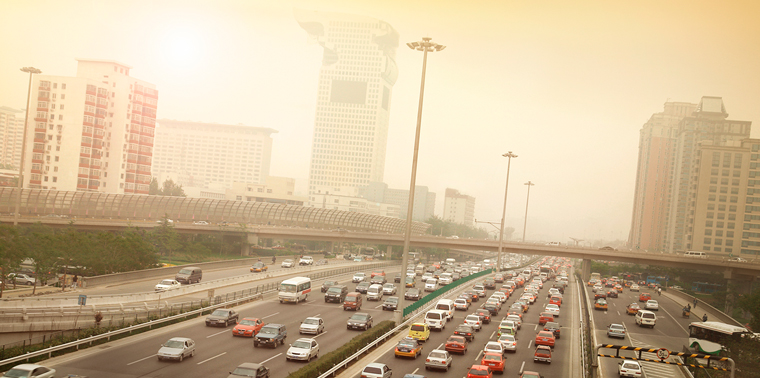January 25, 2018 — Ground-level ozone, or O3, is a hazard to human health and the environment, causing respiratory problems and exacerbating asthma while also harming some vegetation and wildlife. Created when by-products of combustion interact with sunlight, it may cause more than a million deaths each year around the world, along with tens of billions of dollars in crop losses.
From a technological standpoint, this is a fixable problem. Available — though sometimes costly — solutions for scrubbing ozone precursors from smokestack emissions exist. In fact, the U.S. auto industry has already managed to cut vehicle emissions of ozone-exacerbating pollutants more than 99 percent over a few decades, thanks in large part to regulations that required changes to gasoline formulation as well as engine technology. In the U.S., past progress includes a 31 percent decrease in the national average ozone concentration from 1980 to 2016. Emissions of the precursor pollutants have showed similar declines in other parts of the world such as Europe, but large portions of the population still are at risk of dangerous exposures.
Yet even as these countries clean up their ozone act, countries like China and India are dealing with some of the worst pollution the world has ever seen, with increasing ozone concentrations in major cities in recent years.

Average summer daytime concentrations of ground-level ozone vary dramatically around the world. Dots represent data from 4,794 sites 2010–14. Courtesy of Schultz, M.G. et al. 2017. Tropospheric Ozone Assessment Report, PANGAEA, https://doi.org/10.1594/PANGAEA.876108. Supplement to Schultz, M.G. et al. 2017. Tropospheric Ozone Assessment Report: Database and metrics data of global surface ozone observations. Elementa 5:58.
The science on ozone pollution — causes, implications, solutions — has been well understood for decades. As energy demand grows and regulatory environments evolve, can the U.S. and the world take that science to heart, and continue a cleanup that will save lives and make us all breathe a bit easier?
Settled Science
Not to be confused with stratospheric ozone, which provides a protective shield around the planet, ground-level ozone pollution forms when gases composed of nitrogen and oxygen (NOx) and volatile organic compounds (VOCs), interact in the presence of sunlight. Though some ozone (as much as 70 percent in certain parts of the western U.S., though much lower elsewhere) is considered “background,” meaning it does not originate from local, human-produced sources, much is related to the release of NOx and VOCs by factories, power plants, cars, trucks and so on.
Ozone harms human health. “We know that ozone has an irritant effect on the airways. It causes inflammation. That irritation causes a reflex that reduces the lung function, and reduces your ability to get a deep breath in,” explained Mark Frampton, a doctor and researcher at the University of Rochester Medical Center who studies the health effects of ozone. Frampton says there is also some more limited evidence that repeated, long-term exposures can inhibit the growth of lung tissue in children, contribute to the development of asthma and worsen cardiovascular diseases such as atherosclerosis.

Ozone can aggravate symptoms in children who suffer from asthma. © iStockphoto.com/anandaBGD
All those effects of breathing in ozone add up to missed school and work, huge health expenditures, and premature death. One recent study found that at concentrations seen in 2005 in the U.S., 4,700 deaths could be considered ozone-related; along with another important pollutant known as PM2.5, ozone is responsible for as much as 10 percent of the deaths in certain very smoggy places, such as Los Angeles County. The World Health Organization notes that according to several European studies, daily mortality rates can rise by 0.3 percent for every additional 5 parts per billion (ppb) of ozone in the air. A study using data from 2010 found as many as 316,000 deaths in China that year could be attributable to ozone, accounting for 28 percent of all respiratory deaths; in India, with about 450,000 deaths, that rate would be over 32 percent.
Ozone also stunts plants’ ability to photosynthesize, resulting in harms to ecosystems and to crops important to the world’s food supply. One study found that with current projections, in 2030 we would see a hit to the global wheat crop of as much as 26 percent, with other crops like soybeans not far behind. Ozone might produce a crop loss valued at US$35 billion. Another study found that in 2000, nearly half of representative ecosystems around the world were exposed to ozone levels that posed ecological risks, and predicted this would increase by 2050.
A Fixable Problem
Existing technologies for reducing ozone precursor production include “end of pipe” methods of capturing or reducing emissions, and changes to fuels used in power plants or cars and trucks. There are also more downstream ideas that amount to basically scrubbing ozone or its precursors from the air; one 2014 study showed that planting trees around urban areas could help reduce the ozone burden, perhaps at a lower cost than for the more industry-centered technology approaches.
Though some industries continue to push back against what they consider expensive fixes, others, prodded by regulations seeking to reduce ozone pollution, have already made huge gains.
“A lot of it, I think, can be dealt with.” –Gretchen GoldmanFor example, the auto industry once claimed that reducing VOCs and NOx at the same time was not feasible, says Gretchen Goldman, a Union of Concerned Scientists expert whose background is in air pollution and its effects on humans, but the advent of unleaded gasoline and the associated use of the catalytic converter accomplished just that feat. Today, an industry group says that by 2025 passenger vehicle emissions of NOx and “smog-forming emissions” will have dropped 99.8 percent since implementation of the first anti-ozone regulations decades ago.
“There are times in the past when they said things were impossible but they weren’t,” Goldman says. “A lot of it, I think, can be dealt with.”
Setting Limits
The arguments surrounding ozone regulation that do persist, though, center around those pesky parts-per-billion, or ppb, that describes the concentration of ozone in the air we’re breathing.
Regulatory agencies, in their efforts to limit production of the pollutant, must pick a target number, and then hold localities or polluters responsible when they fail to hit it. Over the years, the number set by the U.S. Environmental Protection Agency has changed: the first regulation in 1971 started at 80 ppb for all photochemical oxidants (of which ozone has the most impact), but that was bumped up to 120 ppb in 1979 before dropping back to 80 in 1997.
Since then, a growing body of scientific evidence regarding harm has suggested the need to reduce further: The 2008 revision brought the limit to 75 ppb, and a 2015 version dropped it again, down to 70 ppb. For comparison, China’s standards vary between 50 and 100 ppb, depending on what type of area is being measured; Japan uses 60 ppb, India uses between 50 and 90 ppb, and the World Health Organization recommends aiming for 50 ppb. The European Union has a standard of 60 ppb.
The problem with debating these sorts of numbers is that, unfortunately, any amount of ozone appears to be bad for us.
“As of now, there is no known threshold,” Goldman says. “Scientists don’t think there is a level below which ozone is not harmful. That would suggest that it would always be more protective of public health if it was lower, so the thing they just debate now is what’s protective with an adequate margin of safety.”
The EPA estimates a yearly cost of implementing the new standard in 2025 of US$1.4 billion, compared with public health benefits worth between US$2.9 and US$5.9 billion.The 70 ppb standard, according to EPA calculations, would avoid as many as 160 premature deaths in the U.S. in 2025, as well as stave off hundreds of heart attacks, hospital admissions and emergency department visits, and 230,000 cases of exacerbated asthma among children ages 6 and up. The EPA estimates a yearly cost of implementing the new standard in 2025 of US$1.4 billion, compared with public health benefits worth between US$2.9 and US$5.9 billion.
The new standard was finalized in 2015, but the EPA recently has attempted to delay its implementation, an attempt that was fought off through lawsuits and public outcry.
“There was no stone left unturned,” says Chris Frey, a professor at North Carolina State University who chaired a group known as the Clean Air Scientific Advisory Committee (CASAC) for the update to the ozone standard. “The CASAC review process was lengthy, detailed, and deep. … There is no scientific rationale for delaying implementation of the revised ozone standard.”
Global Challenges
The familiar images of Chinese and Indian cities blanketed with eerie smog, of commuters wearing face masks, of marathoners running through officially “hazardous” air — these are common reminders of how far much of the world has to go when it comes to air pollution in general, and ozone in particular. And the International Global Atmospheric Chemistry Project’s Tropospheric Ozone Assessment Report, which provides detailed data on ozone levels from thousands of monitoring sites around the world, is providing a quantitative basis for concern about adverse impacts to human health and the environment.
China has instituted some aggressive pollution reduction policies, but continued growth in transportation and various industrial sectors may hinder progress toward cleaner air. According to one recent estimate, China’s ozone levels continued to increase in recent years even as other dangerous pollutants such as PM2.5 have been reduced. A new study conducted in 272 Chinese cities found “robust evidence” linking short-term ozone exposure to mortality, and China’s environment ministry has said that dozens of cities exceeded the national ozone standard last year — a standard of 160 µg/m3, equivalent to 80 ppb. Average ozone exposure to Chinese citizens rose by 17 percent from 2014 to 2017, suggesting an additional 12,000 premature deaths per year. Beijing’s average ozone level in 2015 was well over 100 ppb.
Still, the world’s biggest country — and biggest polluter — is clearly trying to turn a corner on air pollution. “China is recognizing that air quality is a significant threat to public health for its own citizens,” says Frey, the EPA CASAC chair, who also holds an adjunct professor position at the Hong Kong University of Science and Technology. The country, he says, is rapidly starting to institute policies aimed at fixing its pollution problems. “When China decides to do something, it can move very quickly to do it,” he says.
As with many other forms of pollution, one thing that’s clear is that we’re all in this together. Other countries have laid a blueprint that could help the most polluted cities in Asia. Mexico City once had ozone levels in the 500 ppb range, but that has been slashed down toward the (still dangerous) level of 120 to 150 ppb; the city implemented plans involving rotating restrictions on vehicle use on certain days, banned leaded gasoline and pushed some industries out of the city.
Sometimes efforts to reduce pollution can backfire: A 2014 study in São Paulo, Brazil, found that a switch to biofuels in vehicles actually might increase ozone pollution. As the price of ethanol rose and more cars switched back to gasoline, ozone levels fell by 20 percent. Clearly, there may be fits and starts as the world fights its smog problem.
As with many other forms of pollution, one thing that’s clear is that we’re all in this together. Some China-generated ozone precursor pollutants actually travel across the Pacific Ocean and fall down toward ground level in the western U.S., causing ozone to increase there. In fact, a 2015 study found that transport of ozone and its precursors from China offset nearly half of the expected reduction in ozone in the U.S. over the 2005 to 2010 period.
Ozone pollution is truly a global problem. The important point to remember, though, is that it is a manageable problem. In a 2008 report on the future of ozone pollution by the U.K.’s Royal Society, experts wrote: “The technology to solve ground-level O3 pollution is widely available and, among the global environmental problems, ground-level O3 is unique in being very controllable.”
If nations choose to deploy these technologies, ozone pollution may one day serve as an example of how we can indeed solve an environmental problem if we put our political wills — and resources — to the task. ![]()
Ensia shares solutions-focused stories free of charge through our online magazine and partner media. That means audiences around the world have ready access to stories that can — and do — help them shape a better future. If you value our work, please show your support today.
Yes, I'll support Ensia!
